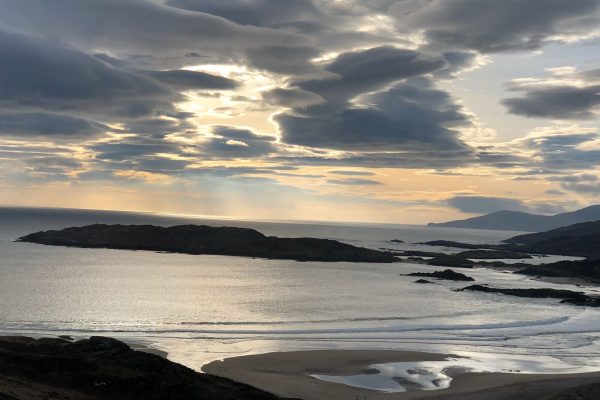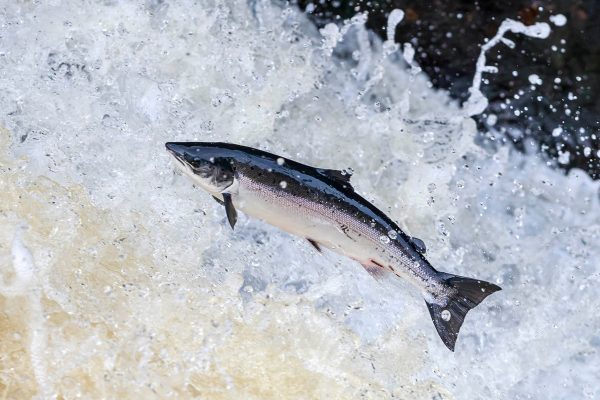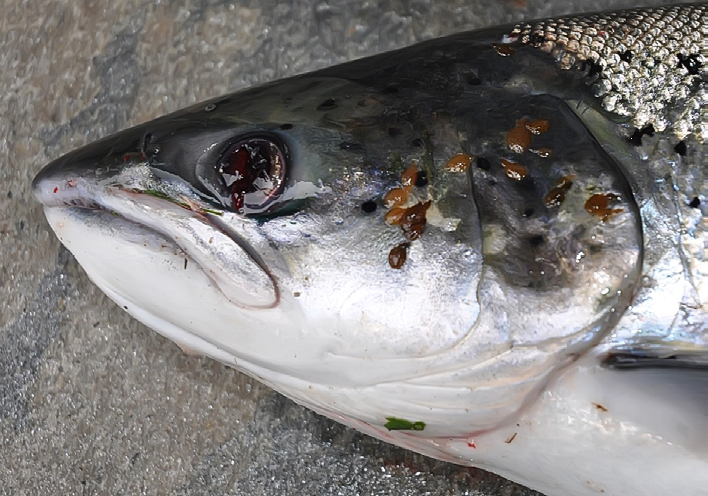Are Open-Pen Salmon Farms Really Sustainable?
Open-pen salmon farms have been encouraged here. But how well do they fit these criteria? Salmon farmers frequently proclaim the sustainability of their industry, claiming that they are eco-friendly and are creating a new blue revolution with their protein rich product. But increasingly their claims are being questioned on the basis of scientific evidence, sometimes from unexpected quarters.
In December 2018 Marine Harvest, the world’s largest producer of Atlantic farmed salmon, held an AGM to change its name to MOWI in honour of its founder, Thor Mowinckel. At the meeting an 84- year-old shareholder castigated the company for polluting nature, wildlife’s habitat and ecosystems, while threatening the future of future generations. He wanted to see a move to land-based farms.
The speaker was Thor Mowinckel himself. He voted against the name change in protest. Others agree with him, as MOWI found out to their cost. In 2021 they were sued in the USA for “false marketing.” They settled the case for $1.3 million and agreed not to use the terms “sustainable” or “eco-friendly” in their advertising there.
Currently MOWI is seeking to construct a large farm in Connemara.
The International Experience
Open-pen farms have been banned or heavily restricted in many countries, because of the environmental damage they cause. They never existed in English or Welsh waters. They are banned in Denmark, Southern Argentina, and the Pacific States of the USA: Alaska, Washington State and California. British Columbia is transitioning away from them. After a ten-year moratorium, they are now permitted in Chile, but not in protected marine areas.
Norway regulates them strictly, fining rule breakers. Licences for sea farms are expensive, while land-based farms are free. A production tax on output was recently introduced. This provides farmers with an incentive to expand overseas, where regulation is lighter. Scotland is facing an increasing clamour for tighter regulation. 2 major recent applications have been Ireland is different. Fish farms are encouraged and subsidised with taxpayer grants. The licencing system is minimal with some farms permitted to stay open, even though their licences are more than ten years expired. The Government is even willing to entertain licence applications in Special Areas of Conservation.
The Irish Government is currently drafting a National Strategic Plan for Aquaculture Development 2030. The plan aspires to provide:
1. Nutritious and healthy seafood with a limited environmental footprint.
2. Economic development and job opportunities for coastal and rural communities.
3. A reduction in pollution.
4. Preserve ecosystems and biodiversity.
5. Contribute to the fight against climate change.
Healthy Food: Toxic chemicals, used to treat sea-lice can contain pathogens, which contaminate farmed salmon, In Canada and Scotland farmers have been found to use illegal poisons. Artificial colourants change the natural grey flesh of farmed fish into the chosen shade of pink. Nutritionists are concerned about dangers, to children, pregnant women and people with a history of cancer. In general controls are minimal and over-reliant on self-regulation.
While there is now much talk about ‘organic salmon farming,’ there is much disagreement about the criteria. Certainly, the product so labelled commands a premium price. It claims to be sustainable. But the fish still need to be produced in cages and treated for disease. It seems bizarre that salmon, which have been chemically treated for sea-lice either directly or through their food and are artificially coloured can be classified as ‘organic.’ Improvements in fish husbandry are welcome, but strict boundaries need to be agreed and properly monitored, a challenging task for the present regulatory system.
Environmental Footprint:
The environmental issues, excluding pollution, fall under 3 categories:
Sea-lice. It has long been known that an infestation of sea lice, which thrive in the cages, poses a serious threat to wild salmon and seatrout. Sea trout, being coastal feeders, are particularly badly affected. In 2019 BBC Panorama showed a wild fish covered with 747 lice and a diver who described the barren seabed and the fish as being “essentially eaten alive.” Farms in Ireland regularly exceed their permitted sea-lice limits.
Recent scientific research on Irish rivers, has clearly shown that heavy lice infection during the smolt migration period has resulted in reduced runs of returning adult salmon the following year, ranging from 19% to 46%. The Irish Government chooses to rely on their in-house scientists from the Marine Institute, who downplay the significance of lice, rather than the overwhelming evidence from Norway, Scotland, Canada and, most importantly, IFI, Inland Fisheries Ireland.
Escapees’ Risk: Fish farm escapees constitute a serious risk, since they may interbreed with wild fish, while also competing for spawning redds and food. Shortly after 48,000 fish escaped in 2021 from a MOWI cage in Scotland, 17 rivers in Scotland and England reported the presence of farmed fish. Fisheries Management Scotland attributed the majority of them to this MOWI outbreak. Escapees can disperse widely and quickly. The consequences of a major escape are serious. MOWI was fined over $6m in 2020 for an escape of 690,000 salmon in Chile. The watchdog stated that this constituted “irreparable environmental damage.” They found that MOWI had failed to maintain appropriate security standards and had used substandard equipment.
They emphasised the risk to the marine habitat from “decomposing mortality,” together with the transmission of pathogens and disease.
Disease: Compared to the 3%/5% commonly found in chicken or cattle farming, mortality in fish farming is high, estimated at 40% in Ireland. It seems that our warm waters help to spread disease commonly found in cages quickly.
Pollution: Open-pen farms can be compared to a town with no sewerage system. The faeces, surplus food and chemicals drop to the seabed, which becomes barren under the cages. They are rarely adequately dispersed by tides, becoming a hazard to the surrounding marine life.
The scale of pollution is serious. The Scottish National Trust estimates that the untreated pollution of a 2,500-tonne farm equates to that of a town of 16,000 people, where the sewerage is, of course,treated.
The community bears all these environmental costs, estimated by one economist as 40% of total
costs, while the polluter avoids payment. The revenue, meanwhile, usually flows to large foreign
multinationals.
Employment: Full time employment in existing farms has been declining in recent years, probably due to increased automation and new job creation has sometimes been exaggerated. If inshore fishermen are deprived of their livelihood, there may be no net increase in employment. On the east coast of America local shell fishermen with strong local support successfully opposed major pens off the coast of Nova Scotia and off Maine. Pollution and unsightly cages must also damage employment in both angling tourism and tourism generally.
Ecosystems and Biodiversity:
The most serious ecological charge against open-pen farms is that they are endangering the
dwindling population of wild salmon. Irish salmon numbers have declined by almost 80% in the last
20 years. Open-pen farms also devastate areas of the seabed, out of sight, except to divers,
destroying shellfish and other marine life in the vicinity of the cages. As Tasmania has now
discovered, its ocean floors have become increasingly barren, birdlife vanishes, and rare fish are
threatened with extinction.
The use of fish meal and salmon oil from wild fish is highly controversial, seriously damaging the
food chain. Salmon feed involves dredging enormous volumes of small wild fish. Consequently, the fish population in third world countries from West Africa to Peru have been seriously reduced, depriving the population of an important source of food and their fishermen of their livelihood.
Climate Change
The industry has a significant carbon footprint, especially with transportation. It also seems that our warmer waters make us more exposed to algae bloom, gill infection and aggressive jellyfish, which enter the cages. In a Bantry Bay farm there were around 100,000 deaths in 2021, due to an outbreak of algal bloom. Shallow coastal water makes them vulnerable to the rapid spread of pollution and disease. In an era of global warming this situation is unlikely to improve. Climate change can only exacerbate the problems.
The industry may change. There are now at least 75 land-based projects in the planning stage, under construction or already in operation. New Zealand is joining Maine, Florida and Wisconsin in the US, as well as Switzerland, Dubai, China and Japan. Thor Mowinckel must be pleased. But open-pen salmon farms fail to meet any of the criteria set out in our National Strategic Plan for Aquaculture and should not form part of our future aquaculture industry.
Published in the Irish Times, February 2023.









